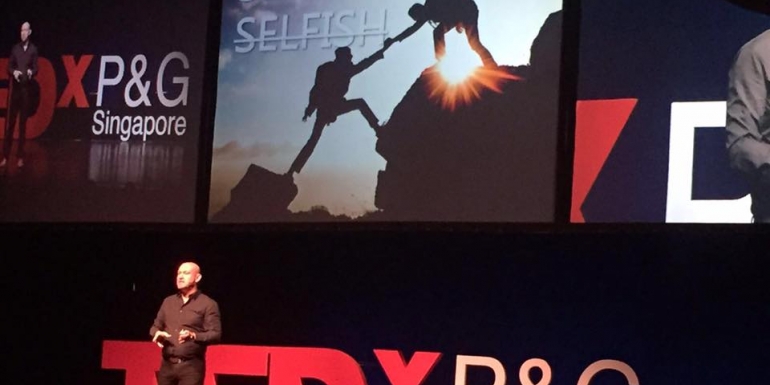“What was TEDx like?” I’ve been asked by my speaker and non-speaker friends. The immediate analogy that springs to mind is:
“Like a Pro-tennis player, playing a championship squash match”.
Now I’m not a pro-tennis player but I imagine that the fitness, hand-eye co-ordination and timing would help a such a player in a game of squash. But the confined space, rapid returns, and the need to flick the wrist would feel awkward.
I have been speaking professionally for 17+ years and have spoken on stages with thousands in the audience, as well as at the front of the room with small groups of 20 to 30 people. With this experience I first thought that doing a TEDx would just be another speech – but I was wrong.
My first hint that I should prepare for a different format was hearing that TEDx organizers don’t particularly like ‘professional speakers’. The reason for this is that pro-speakers focus on the presentation and TED and TEDx is all about the idea. One idea, an idea worth sharing.
My second hint was watching a whole bunch of TED talks and realizing that; 1) that there is not a lot of movement on stage and 2) that there is absolutely no audience interaction (in fact this is forbidden).
Two fundamental strategies of professional speakers removed; plus, you are going to have to forget your 7-Steps approach that fits neatly into a 45 or 60-minute keynote.
With this in mind, I submitted the first draft of my speech to the TEDx organizers. They liked the idea that I had for the talk, but observed that I had included a couple of ‘models’ that they thought would take much longer than the 18-minute to explain. NO MODELS! – there goes another strategy that pro-speakers and trainers love to employ.
So now I knew what I couldn’t use, what was left in my toolkit to communicate my idea and make it stick?
Stories, metaphors, analogies, rhetorical questions and humor.
So I set to work dusting of some old stories, repurposing some current ones and trying a new one to make the point. But something was still missing – emotion.
Getting Coached
A huge benefit from accepting the invitation to speak at a TEDx was the opportunity to get coached again. Realizing that I had returned to the status of ‘newbie’ opened my mind and my heart to get feedback from my peers and even those that I had coached and mentored in the past.
With this coaching, the process had begun. The process was to strip away any trace of ‘teaching’ and in its place put in an emotional connection to the audience so that they could ‘feel’ the idea I was sharing. And the only way that this was going to happen was if I got back in touch with those emotions that I felt when I uncovered my idea.
The idea was two-fold, “You have been framed by your culture since birth” and that “You can’t lead others until your lead yourself”.
I had learned both these ‘truths’ at a very challenging time in my life and it had been psychologically and emotionally painful. As I have now applied the strategies of Self-leadership I am now in a good place and it seemed, at first, unnecessary to revisit the pain. My coaches disagreed. They challenged and encouraged me to be authentic. I am grateful for their perseverance as the impact of my speech was multiplied by me being vulnerable. I have given a couple of keynote presentations since my TEDx and continued to be vulnerable and the impact on the audience has been transformational.
Being funny and other stuff

There’s a saying in professional speaking:
“Do I need to make them laugh? – Only if you want to get paid!”
I’ve never had trouble getting an audience to laugh, but I’ve never scripted it. Knowing I had only 15 to 17 minutes, I tried to spot where were the funny moments and prepare for the laugh. This was tough. But prior preparation prevents poor performance. By practicing my speech with as many people as I could get to sit still for 20-minutes, I began to find the funny.
I received a great piece of feedback from a friend whose TEDx is titled “The Cancer that died of laughter”. His feedback was that any images on slides had to ‘add value’ and not be obvious. My talk was serious and so the slide created ‘comic relief’. Changing my image made all the difference.
Of course, in typical Murphy’s law – on the day my slides did not project immediately and I missed my first visual joke – but it didn’t matter and my thousands of hours of on-stage experience enable me to breeze through a minor technical hitch.
In Summary
I think to be a professional, we need to challenge ourselves in different ways to continue to grow and stay current. I have previously done stand-up comedy and taken a program on presenting in a virtual environment. TEDx gave me the opportunity to hone my ‘art of speaking’. The venue for my TEDx was theater and standing no that stage, with spotlights in my eyes, allowed me to tap my ‘inner thespian’.
It’s been a long-time since I practiced a speech 50x but I recommend the experience. The constant polishing resulted in something shiny and new.
————————————————————————————————–
? Andrew Bryant is a Global Expert on Self Leadership & Leading Cultures. He partners with international & global organizations to develop leaders and leadership cultures. www.selfleadership.com | +65 64080702
? Invited to speak in 20+ countries on 4 continents with 150,000+ people inspired, he is known to be an effective, confident, humorous & thought provoking motivational & TEDx speaker. www.andrewbryant.global



